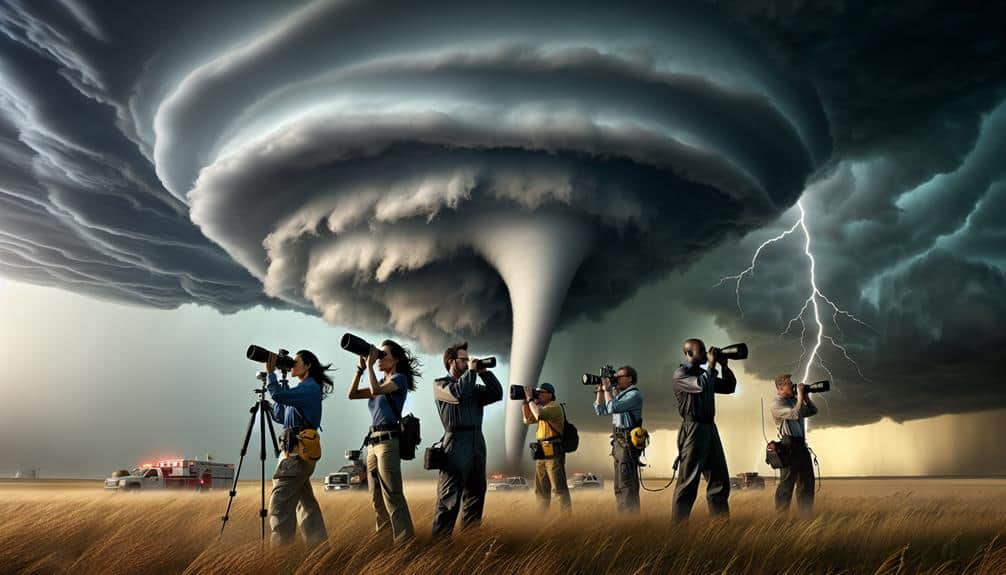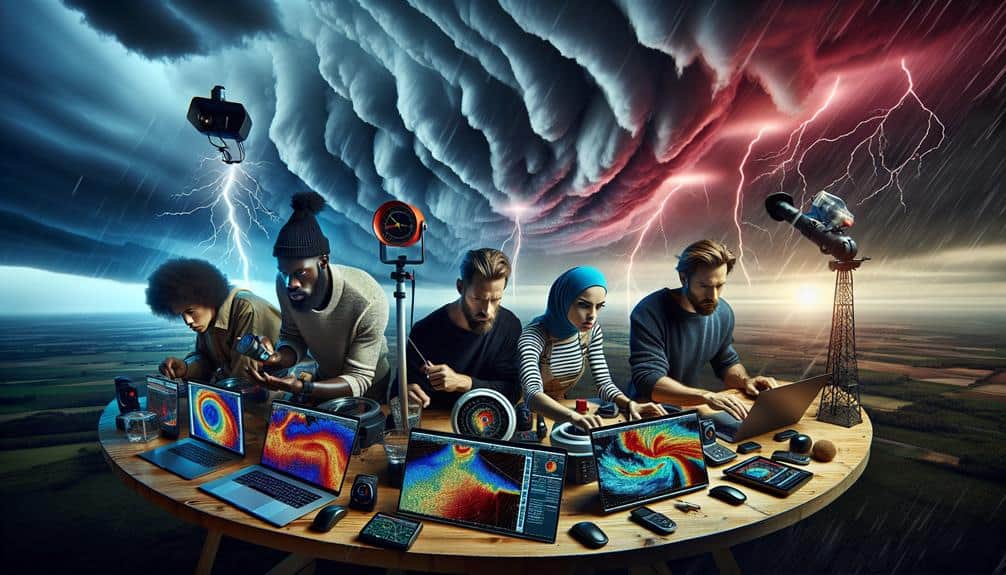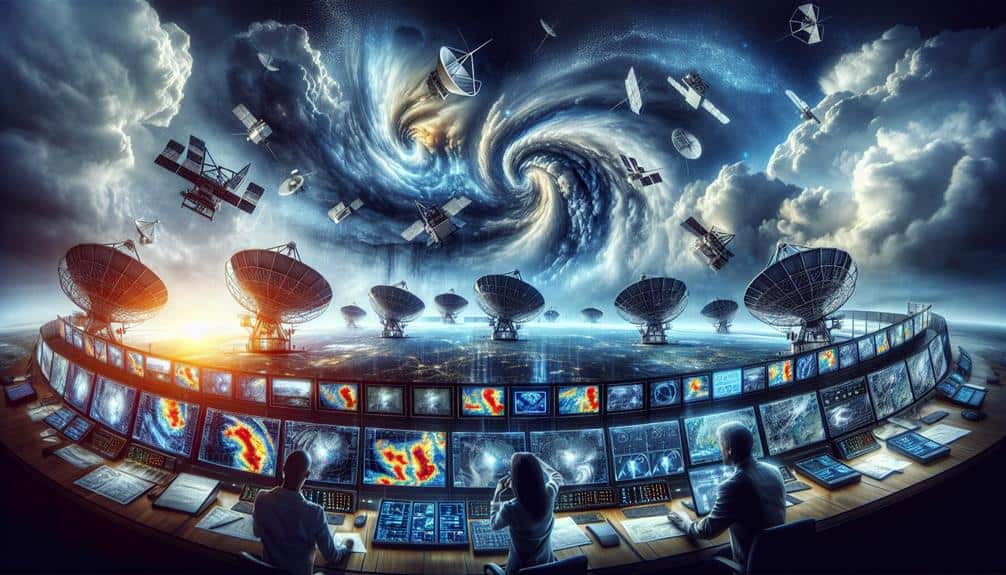We rely on Doppler radar to measure storm intensity, track wind speeds, and differentiate precipitation types. Satellite imagery offers a thorough view of storm systems and identifies key cloud formations. Advanced weather models analyze variables like temperature and atmospheric pressure for precise predictions. Real-time analysis of radar data and satellite imagery guarantees accurate tracking. Mobile apps equipped with radar and GPS navigation tools provide up-to-date updates and strategic routing. By integrating these methods, we can effectively track storms and make informed decisions. With further insights, you'll grasp the intricacies of storm chasing and improved tracking techniques.
Key Points
- Utilize Doppler radar and satellite imagery for real-time storm tracking and intensity assessment.
- Incorporate weather models to predict storm paths and evaluate forecast reliability.
- Monitor atmospheric conditions with advanced meteorological instruments for accurate data on temperature, humidity, and wind patterns.
- Use mobile apps with GPS navigation and real-time updates for strategic positioning and safety during storm chasing.
Utilizing Weather Radar
Weather radar systems provide us with real-time data necessary for tracking storm development and movement accurately. By leveraging Doppler radar technology, we can measure storm intensity and provide predictive tracking to forecast the storm's path.
Doppler radar detects changes in the frequency of the returned radar signal, indicating wind speed and direction within a storm cell. This data is essential for identifying potential tornadoes or severe weather patterns.
Our radar systems also differentiate between precipitation types—rain, snow, sleet—by analyzing the returned signal's reflectivity. Higher reflectivity values often indicate more intense precipitation, which helps us assess storm intensity. This information allows us to issue timely warnings and advisories, giving people the freedom to make informed decisions about their safety.
Predictive tracking uses algorithms to project the future movement of storm systems based on current radar data. By analyzing the velocity and trajectory of storm cells, we can estimate arrival times and potential impact areas. This level of precision is invaluable for emergency responders and the public alike, enabling proactive measures rather than reactive responses.
Essentially, weather radar systems empower us to stay ahead of the storm, ensuring our safety and freedom.
Reading Satellite Imagery
In addition to radar data, satellite imagery offers a comprehensive view of storm systems by capturing visual and infrared data from space. This capability allows us to observe cloud formations and weather fronts with unparalleled accuracy. By analyzing these images, we can identify the structure and development of storm systems, which is vital for predicting their behavior.
When we examine satellite imagery, we focus on several key elements. Cloud formations provide insights into the type and severity of the storm. For instance, towering cumulonimbus clouds often indicate severe thunderstorms or tornadoes. Weather fronts, visible as distinct lines of cloud demarcation, signify the boundaries between different air masses, which can be the breeding grounds for storm activity.
Additionally, satellite data lets us track wind patterns and moisture levels. Infrared images help us determine the temperature of cloud tops, revealing the storm's intensity. Wind patterns observed from satellite data can highlight areas of rotation, which are essential for spotting potential tornadoes. Moisture levels, indicated by water vapor imagery, show the amount of moisture available to fuel storm development.
Analyzing Weather Models
Let's start by examining how to interpret model outputs, ensuring we grasp the data presented.
We'll compare different models to assess their reliability and accuracy.
Understanding Model Outputs
To effectively analyze weather models, we must scrutinize the numerical data and algorithms that predict storm trajectories and intensities. By delving into the intricacies of model accuracy and data interpretation, we can derive actionable insights.
Understanding the output begins with recognizing the variables involved—temperature, humidity, wind speed, and atmospheric pressure. These elements interact in complex ways to form the basis of our predictive efforts.
When evaluating forecast reliability, we should consider the initial conditions and boundary settings of the models. High-quality input data leads to more precise forecasts, allowing us to refine our tracking techniques. It's vital to run multiple simulations and compare them to identify consistencies and discrepancies. This approach helps us to gauge the robustness of a forecast and anticipate potential deviations.
Furthermore, interpreting ensemble models, which aggregate multiple runs, offers a probabilistic perspective rather than a deterministic one. This aids in understanding the range of possible storm paths and intensities.
Comparing Different Models
When we compare different weather models, evaluating their strengths and limitations helps us choose the most reliable forecasts for storm tracking. Each model has unique algorithms tailored to capture specific aspects of storm dynamics, contributing to varying levels of model accuracy in storm predictions.
The Global Forecast System (GFS) and the European Centre for Medium-Range Weather Forecasts (ECMWF) are often at the forefront of our model comparison. The GFS offers frequent updates, beneficial for real-time tracking, but sometimes lacks precision in certain scenarios. Conversely, the ECMWF is renowned for its accuracy but provides fewer updates, which might delay actionable insights.
Additionally, we consider regional models like the North American Mesoscale (NAM) model that offers high-resolution data, essential for understanding localized storm dynamics. The trade-off here is that while the NAM provides detailed information, it may not always align with broader, global models, necessitating a careful balance in our analysis.
Ultimately, our goal is to synthesize data from multiple models, leveraging their respective strengths to improve storm predictions. By refining our approach through continual model comparison, we enhance our ability to deliver precise and actionable storm tracking insights.
Identifying Key Patterns
Identifying key patterns within weather models involves scrutinizing various data outputs to pinpoint recurring trends and anomalies in storm behavior. By engaging in storm behavior analysis, we can effectively enhance our storm tracking techniques and bolster prediction accuracy. We start with high-resolution atmospheric data from satellite imagery, Doppler radar, and weather balloons. These data sources allow us to observe pressure systems, temperature gradients, and moisture levels.
Pattern recognition is pivotal in this process. We look for specific indicators such as cyclogenesis, vorticity, and wind shear, which often precede severe weather events. By analyzing these parameters over time, we can identify patterns that suggest the formation of tornadoes, thunderstorms, or hurricanes.
Moreover, we utilize ensemble forecasting to compare multiple weather models simultaneously. This approach helps us recognize consistencies and discrepancies among models, providing a broader perspective on potential storm paths and intensities.
Advanced algorithms and machine learning techniques further refine our ability to predict storm behavior by continuously learning from past data and improving over time.
Tracking Storm Movement
Accurately tracking storm movement demands a thorough understanding of meteorological data and predictive modeling techniques. We rely on advanced storm prediction models to determine potential pathways and evolution of storm systems. For effective storm interception, we analyze real-time radar data, satellite imagery, and numerical weather predictions. This approach allows us to anticipate changes in storm intensity and direction with high precision.
When engaging in storm photography, we must position ourselves strategically to capture the storm's most dramatic features while maintaining storm safety. Utilizing tools like GPS tracking and mobile radar units, we can navigate around the storm's periphery, ensuring that we're in the best spot for visualization without compromising our safety.
Predictive models such as the High-Resolution Rapid Refresh (HRRR) and the Global Forecast System (GFS) provide us with critical insights into storm dynamics. By cross-referencing these models with live data feeds, we can refine our storm tracking strategies in real-time. This analytical approach maximizes our ability to document severe weather phenomena while minimizing risk.
Ultimately, our goal is to balance the thrill of storm chasing with the imperative of safety, leveraging scientific tools to guide our every move.
Monitoring Atmospheric Conditions

To effectively monitor atmospheric conditions, we employ advanced meteorological instruments and real-time data analytics to scrutinize variables such as temperature, humidity, and wind patterns. These parameters are crucial for storm prediction and enhancing forecasting accuracy. By utilizing Doppler radar, weather balloons, and satellite imagery, we gather an extensive suite of data that allows us to understand the dynamic behavior of storm systems.
Weather station monitoring is integral to our approach. These stations are equipped with sensors to continuously collect data on atmospheric pressure, temperature, and wind speed. This data collection is essential for constructing accurate models of storm development and progression. High-resolution data from these stations feed directly into our forecasting systems, enabling precise and timely predictions.
Our analytical approach doesn't stop at mere data acquisition. We employ sophisticated algorithms to interpret data patterns and predict potential storm trajectories. This process, known as numerical weather prediction, leverages computational power to simulate atmospheric conditions and forecast storm behavior. By integrating observational data and predictive modeling, we achieve a higher level of forecasting accuracy.
In essence, our commitment to monitoring atmospheric conditions with cutting-edge tools and methodologies empowers us to provide reliable storm predictions, ensuring we stay ahead of severe weather events.
Using Mobile Apps
By leveraging mobile apps, we can access real-time weather updates and enhance our storm-tracking capabilities with precision. These tools utilize GPS navigation for accurate location tracking and provide thorough radar and satellite imagery.
Let's explore how these features contribute to effective storm monitoring and decision-making.
Real-time Weather Updates
In today's digital era, leveraging mobile apps for real-time weather updates can greatly enhance our ability to track storm developments with precision and immediacy. When we engage in storm spotting and storm chasing, having access to accurate, up-to-date information is crucial. It allows us to make informed decisions based on the latest weather alerts and storm predictions.
Mobile apps designed for storm chasers provide a myriad of functionalities essential for our pursuits:
- Radar Imagery: Real-time radar images allow us to visualize storm patterns and predict their movements, giving us a strategic advantage in positioning.
- Push Notifications: Instant weather alerts make sure we're promptly informed about any sudden changes in storm intensity or direction, enhancing our response time.
Using GPS navigation tools via mobile applications gives us with accurate routing capabilities and ensures we can travel safely and effectively during storm tracking pursuits. Integrating these tools into our storm chasing gear boosts our capacity to navigate challenging terrains and react promptly to changing storm patterns. By leveraging advanced storm tracking technology, we can forecast storm routes with greater precision and adjust our paths in real-time to maintain an ideal vantage point.
Mobile applications like Google Maps, Waze, and specialized storm chasing apps are essential in our toolkit. These platforms not only provide step-by-step directions but also incorporate live traffic updates, road closures, and weather conditions. This extensive data allows us to avoid potential dangers, guaranteeing our safety while pursuing unpredictable weather systems. Furthermore, the capability to share our location with team members in real-time promotes improved coordination and cooperation.
Integrating GPS navigation into our storm prediction approach empowers us to make informed decisions based on the latest data. This combination of technology enhances our situational awareness and operational efficiency, enabling us to track storms with accuracy and agility. Essentially, these mobile applications are vital for optimizing our storm chasing missions, ensuring we remain ahead of the storm.
Radar and Satellite Imagery
Leveraging radar and satellite imagery through mobile apps, we gain invaluable real-time data that enhances our ability to track and analyze storm developments with scientific precision. These tools provide us with critical insights into storm identification, precipitation patterns, cloud formations, and wind speeds. By utilizing mobile apps, we can make informed decisions swiftly, ensuring our safety while maximizing our observational opportunities.
Radar imagery allows us to pinpoint areas of heavy rainfall and potential hail through reflectivity measurements. This helps in identifying precipitation patterns and estimating rainfall intensity. Satellite imagery, on the other hand, offers a broader perspective, capturing cloud formations and overall storm structure. This dual approach enables us to correlate ground-level radar data with atmospheric conditions observed from space.
Here are three essential features to look for in mobile apps when tracking storms:
- High-detail radar imagery: Provides detailed visualizations for storm identification, allowing us to assess precipitation patterns accurately.
- Satellite overlays: Offers in-depth views of cloud formations and storm morphology, aiding in understanding storm dynamics.
Frequently Asked Questions
How Do You Stay Safe While Storm Chasing?
We prioritize safety precautions and emergency preparedness. We monitor weather updates, use reliable equipment, and maintain a safe distance from severe weather systems. We always have an escape route and emergency supplies ready to guarantee our safety.
What Equipment Is Essential for Storm Chasing?
When it comes to storm chasing, our lifeline is robust camera gear, GPS, and reliable communication tools. Safety equipment is essential. Think of it as an orchestra; every piece must work in harmony for success.
Can Beginners Join Storm Chasing Tours?
Yes, beginners can join storm chasing tours. There are numerous tour options designed for varying experience levels, ensuring safety and education. These tours provide expert guides, scientific equipment, and opportunities to learn storm behavior and meteorological analysis.
What Are the Risks of Storm Chasing?
So, we love chasing unpredictable weather patterns with our "extensive" preparation. But hey, if we ignore safety precautions and strategies, what's a little risk of getting caught in a tornado? Freedom comes with a twist, right?
How Do You Identify the Best Locations for Storm Chasing?
We identify the best storm chasing locations by analyzing weather patterns and topography. Utilizing advanced forecasting tools and technology, we predict storm paths and select areas that maximize observation opportunities while considering safety and accessibility.

